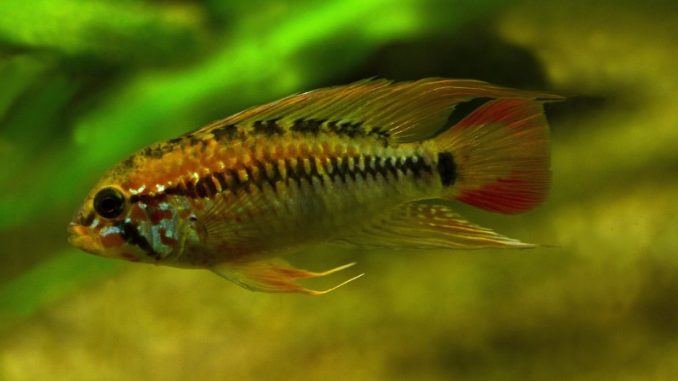
Dwarf cichlids are small-sized cichlids that are endemic to South America and West Africa. Other dwarf cichlids originate from the alkaline waters of African rift lakes such as Lake Malawi and Lake Tanganyika.
South American dwarf cichlids feature rainbow colors and patterns. African dwarf cichlids usually show bright yellow/red colors with hues of blue and green. These fish are known for their peculiar small size, peaceful temperament, and high adaptability.
Dwarf cichlids are peaceful and have a shy, lively nature. They make great additions to community tanks due to their relative lack of aggression and color appearance.
TABLE OF CONTENTS
Dwarf Cichlid Facts & Overview
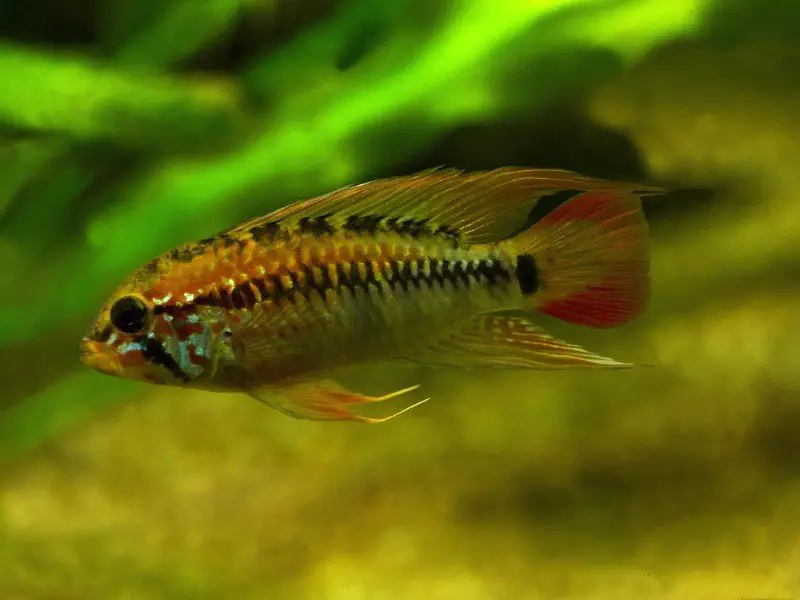
| Category | Rating |
| Care Level | Moderate |
| Temperament | Generally peaceful but may show territorial aggression when breeding |
| Color | Various colors, patterns, and shapes |
| Lifespan | ~5-10 years |
| Size | ~2.3-4 inches |
| Diet | Omnivore |
| Family | Cichlidae |
| Minimum Tank Size | 20 gallons |
| Tank Setup | Freshwater, plants, caves |
| Compatibility | Other similar size cichlids, peaceful |
There are several species under the tag name “dwarf cichlid.” Cichlid fish that are small in size (about 4 inches) are called dwarf cichlids.
Examples of South American dwarf cichlid species include:
- Apistogramma cacatuoides
- Nannacara anomala
- Mikrogeophagus altispinosus
Species of West African dwarf cichlids include:
- Pelvicachromis pulcher
- Nanochromis transvestitus
- Steatocranus glaber
The natural habitat of South American dwarf cichlids features either clear water, black water, or white water. The water is soft and slightly acidic. The water is hard and salty in some areas. South American dwarf cichlids can survive in hard water. Spawning will only be effective in soft water.
African dwarf cichlids live in lakes, rivers, and streams along the coast. Finding dwarf cichlids in great rift lakes such as Lake Malawi is also possible. This water is highly mineralized and features high oxygen concentration and stable waters.
The lifespan of dwarf cichlids is 5–10 years. The fish are readily available in the wild, but their availability in pet stores depends on a few factors.
Dwarf cichlids cost $4–$40 depending on availability, origin, and species. The most common species is the Apistogramma cacatuoides.
Appearance & Behavior
Dwarf cichlids are small fish with flat bodies and strong fins. Their colors vary from one species to another. Color and pattern can range from blue, red, green, and orange to brown and black. These vibrant colors make dwarf cichlids popular among aquarium hobbyists.
Male dwarf cichlids are larger than females, but the females have a much rounder belly than male fish. Both sexes feature bright colors depending on cichlid species. Male Apistogramma cacatuoides have red and yellow colors, while females appear dull with a black line extending alongside its flanks.
Dwarf cichlids will swim frantically in the water, sometimes settling at the bottom of the tank or nick on other tankmates when stressed. The fish show signs of aggression and territorial behavior when breeding.
Dwarf cichlids measure 2.3–4.0 inches (5.8–10.16 cm) in length but can grow up to 4.7–5.1 inches (12–13 cm). This fish weighs 1.6–3 ounces (45–85 g) and requires a tank with a 20-gallon capacity.
Typical Behavior
Dwarf cichlids will not swim in schools. The fish are shy and stay among plants or in places where the fish feel safe.
They are peaceful, but males show some aggression when breeding. These fish will strike at opponents and will bite or nip other fish. Dwarf cichlids will flare their fins, gills, and mouth in an attempt to intimidate other fish.
Dwarf cichlids are active during the day and will swim at the mid-level or bottom of the tank. They prefer to hide among plants, rocks, and driftwood but will come out in the open to feed. Dwarf cichlids will stay motionless when sleeping during the day or night.
Dwarf cichlids love to pick at food that sinks to the bottom of the tank. Feed them flakes, pellets, frozen, or live foods, and provide them with caves, overhangs, and grottos for spawning.
Dwarf Cichlid Care
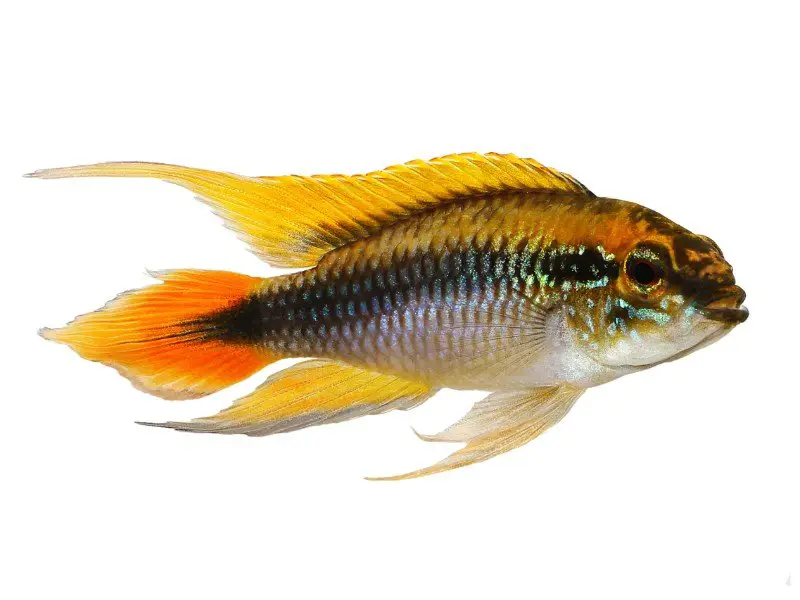
Mimicking their natural environment in tanks by adding plants, rocks, and driftwood is a good idea. Dwarf cichlids also breed in caves and crevices, so add some rocks to create areas for the fish to spawn.
Captive South American dwarf cichlids’ diet should include all tropical flake food, live food, and frozen food. An African dwarf cichlid diet should consist of an all tropical flake or pellet food for omnivores, with the occasional live food treat (bloodworms, brine shrimp, or blackworms).
Dwarf cichlids are also prone to diseases like the Malawi bloat, white spots, and ich. Symptoms include appetite loss, rapid breathing, lethargy, cloudy eyes, and red marks that look like blood worms in the dorsal fin.
Providing the proper aquarium care, such as frequent water changes and chemical filtration, will ensure the fish stay healthy.
Habitat and Tank Requirements
African dwarf cichlids live in the warm and plant-filled tropical waters of Lake Malawi, Lake Tanganyika, and lakes, rivers, and streams along the coastline of West Africa. The plant-filled water and the rocky boundaries of Lake Tanganyika make it the perfect home for dwarf cichlids.
Recreate their natural habitat by adding smooth rocks and driftwood to the tank. Live plants are crucial in dwarf cichlid aquariums, as they provide shelter, spawning sites, and sustenance for the dwarf cichlids.
African dwarf cichlids prefer water temperature between 75°–85°F (23.8°–29.4°C), with pH levels around 7.8–8.5, and soft to moderately hard water.
Rain forests and Savannas in South and Central America provide the perfect home for South American Dwarf cichlids. These waters are naturally filtered by plants, overhangs, and swamps with little to no current. The water can be clear, white, or black, and the hardness ranges from soft to very soft.
South American dwarf cichlids thrive in soft and slightly acidic water, with temperatures of 78º–84 ºF (25.5–28.8 ºC). The pH levels should stay between 7.0 and 7.5.
Tank Conditions
Dwarf cichlids like plants and rocks for hiding spots. Creating a natural habitat with plants, rocks, and driftwood will give the fish places to retreat when they feel threatened.
Tank requirements will vary depending on the origin of the fish; however, a 20-gallon tank will suffice for most dwarf cichlids.
Sand or fine gravel is the best substrate for dwarf cichlids. Round, smooth stones will not cut the dwarf cichlids’ delicate stomachs. Decorating the tank with plants provides a spawning site for breeding fish.
Neutral to moderately alkaline water is suitable for dwarf cichlid fish. Keep the pH level between 7.0 and 8.5. pH levels between 7.8 and 8.5 are suitable for African cichlids, whereas South American cichlid habitats should have a pH level between 7.0 and 7.5.
Dwarf cichlids do well in hard or soft water, but breeding in extremely hard water is impossible. Provide soft to moderately hard water with a pH range of 6.0 to 8.0 for the best results.
Filtration systems keep the aquarium clean. Keeping the water clean and sterile is vital for the fish’s health. Filters keep the tank free from large debris and waste without disturbing their habitat.
Tank Mates
Dwarf cichlids are peaceful and do well with other non-aggressive fish species. Beware that male dwarf cichlids show aggressive behavior towards other fish when breeding or spawning.
Dwarf cichlids are compatible with most fish species. They are particularly compatible with their own species. Male and female tank mates breed readily. The fry will need to live in a separate breeding tank to keep them safe.
Large tetras, gouramis, angelfish, and smaller plecostomus are good dwarf cichlid tank mates. Aquarists can add shrimp, snails, or other small fish to the tank too. These non-fish tank mates do not pose a threat to cichlids.
Disease
Dwarf cichlids are susceptible to the same diseases as other fish. Some of the most common diseases include Malawi bloat, ich, and Iridovirus.
An increase in protozoan parasites that eat away the fish’s digestive tract causes Malawi bloat. Symptoms include bloating and swelling of soft tissue near the stomach, lethargy, lack of appetite, and abdomen swelling. Treating the tank with metronidazole will kill the parasites.
Ich is a tiny parasitic organism that attaches to fish and causes a disease called white spot disease. Symptoms of this disease include white or gray spots all over the fish’s body and bruises or scale loss. Ich can cause sudden death if it’s not treated. Vets recommend treating ich with copper-based medications, malachite green, or formalin.
Iridovirus is a viral infection suspected to emanate from commercial fish production, fish trade, and stocking activities. Iridovirus causes bleeding at the base of the fins and enlargement of the spleen and kidney.
Symptoms of Iridovirus include lethargy, loss of appetite, discoloration, and white feces. There is no known cure for Iridovirus, but preventing stress, maintaining a healthy diet, and reducing overcrowding can prevent it from spreading.
Diet and Feeding
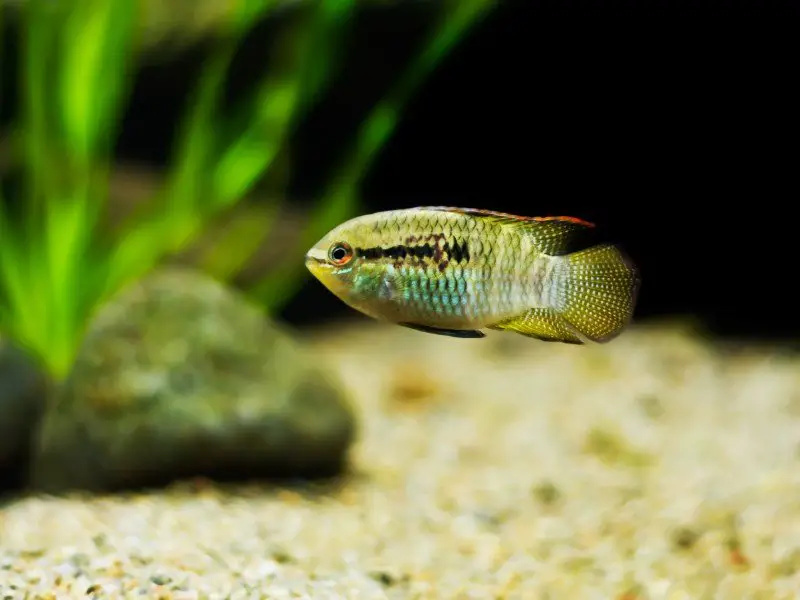
Dwarf cichlids are omnivorous and can eat both plant and animal matter. The fish enjoy munching on algae and other vegetation in the wild while supplementing their diet with insects and larvae.
Fish will thrive on tropical flake food, frozen bloodworms, tubifex worms, and brine shrimp. Pellet food and algae wafers also make good supplemental food for the dwarf cichlids.
Wild dwarf cichlids need to eat a live food diet. Fish keepers should feed the fish commercial flake food once the dwarf cichlids get used to their surroundings.
Feeding once or twice daily is best for the fish’s health. Mealtimes should not exceed two or three minutes. Daytime feeding will ensure the dwarf cichlids get enough food while minimizing the chances of overfeeding.
Breeding
Dwarf cichlids are among the easiest cichlids to breed. There are several species of dwarf cichlids, but they breed in the same manner.
Dwarf cichlids have specific breeding conditions. They will need a separate breeding tank to initiate breeding. A 10-gallon tank is enough space to accommodate the breeding process. Dwarf cichlids will breed in slow-moving water, so a filter with a baffle is necessary.
Choose a healthy male and female fish to breed. Introduce the two fish to their new tank and allow them to settle in for a few days. Maintain the tank temperature between 75 and 80 degrees Fahrenheit (24-27 degrees celsius) and the pH level between 6 and 6.5 for optimal breeding conditions.
Introduce plants, rocks, and wood into the tank to simulate the dwarf cichlids’ natural environment. The female will deposit her eggs on plants, while the rocks and wood serve as spawning sites.
Male dwarf cichlids will become brighter and create territories around the bottom of the tank when the fish are ready to breed. The female dwarf cichlid will entice the male into a cave where she will release her eggs. The male will then fertilize the eggs, after which the female will chase him away.
The eggs will hatch after 2-5 days. Female dwarf cichlids protect their fry for up to four weeks. The fry feeds on algae, but you should introduce other foods such as bloodworms to ensure the fry gets enough nutrients.
Feed breeding dwarf cichlids a diet of high-protein foods such as brine shrimp and bloodworms. Ensure the tank is clean and free of harmful bacteria and ammonia. A canister filter will help keep the water clean and free of harmful pathogens.
Should You Get a Dwarf Cichlid for Your Aquarium
Dwarf cichlids are an excellent addition to an aquarium tank. The fish come in a variety of colors, from a striking yellow to a deep red. Dwarf cichlids are hardy fish and can adapt to a wide range of water conditions.
Having dwarf cichlids in an aquarium will add to the aesthetic appeal of the tank and provide hours of entertainment.
Dwarf cichlids are shy fish, but their outgoing nature and activity level make up for it. They are peaceful fish despite showing territorial aggression when breeding.

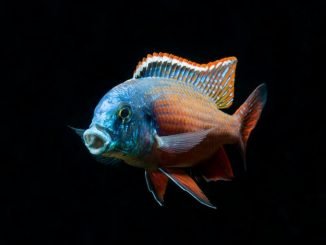
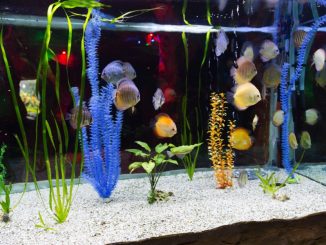
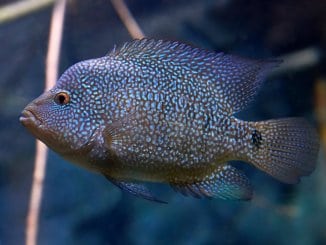
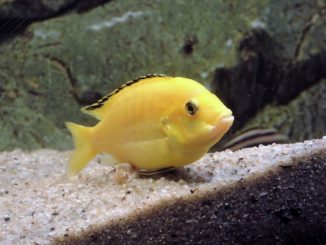
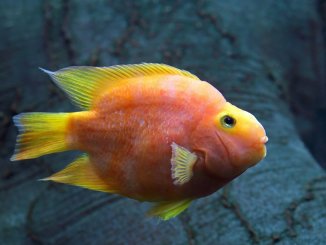
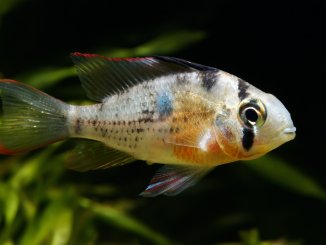
Be the first to comment